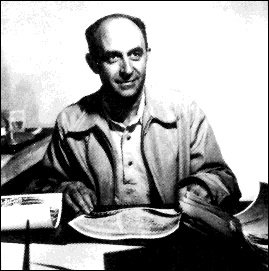Fermi, Enrico (1901–1954)

Enrico Fermi was an Italian-American physicist and Nobel Prize winner (1938), who worked mainly in the fields of nuclear physics and quantum mechanics. Fermi discovered the element neptunium and proved that neutron bombardment of most elements produces radioisotopes of those elements. Fermi produced the first self-sustaining chain reaction in uranium and in 1942 built the world's first nuclear reactor.
Early career
Enrico Fermi was born in Rome on 29 September 1901. He was a brilliant student and gained his doctorate in physics from the University of Pisa at the age of 21. The subject of his thesis was X-rays.
In 1927 Fermi became a lecturer at the University of Rome, where he continued his researches. In 1929 he was elected a member of the Italian Academy, the highest honor Italy can bestow in the cultural field. And then, in 1934, at the end of a series of researches lasting 10 years, Fermi made a fundamental discovery. Among the particles emitted by radioactive substances are neutrons, whose existence had been discovered only a few years earlier. These neutrons carry no charge. Fermi found that when they were used for bombarding targets which were normally stable, the target material itself became radioactive and began to emit radiation. In doing so it eventually turned into another material. For example, iron, when made artificially radioactive by neutron bombardment, turned into manganese. In this way, Fermi found about 80 new artificial nuclei.
Work in the United States
About this time, Italy, under Mussolini, started to copy the racial policies of Nazi Germany. This affected Fermi directly because his wife was Jewish. He therefore gladly accepted an invitation in 1937 to lecture at Columbia University in New York. He did not return to Italy. His work on artificially radioactive substances brought him recognition in 1938 from the Swedish Academy, which awarded him the Nobel Prize in Physics. He became professor of physics at Columbia University in 1939.
Early in 1939, before the start of the Second World War, Fermi and a group of other prominent scientists realized that the Germans might well be working towards the development of an atomic bomb. This prospect frightened them, and so they took steps to ensure that Germany would not be the only country to possess such a weapon. Of course, what they really hoped was that if they could demonstrate to the Germans the awful power of the bomb it would never actually have to be used. The scientists, who included, as well as fermi, Leo Szilard and Eugene Wigner, two Hungarian-born physicists who had emigrated to the United States, suggested to Albert Einstein that he should write to President Roosevelt. Einstein was the most famous scientist then alive, and his letter carried some weight. It said, briefly, that there was reason to believe that uranium could be made into a powerful new source of energy, that recent research by Fermi and Szilard in the United States, and by Joliot in France, had indicated the likelihood that a chain reaction could be set off which would release vast amounts of energy and would produce new radioactive elements. This reaction, observed the scientist's letter, might well be exploited for the manufacture of a new and immensely destructive atomic bomb.
The letter was delivered personally to the President, who immediately ordered that a consultative committee for uranium should be established. All facilities and resources were placed at the scientists' disposal. They began work at once to find a way of harnessing the power within the atom in such a way that it could be released as an explosion. Some two more years went by before this was achieved. Under Fermi's direction a reactor successfully produced atomic energy for the first time in Chicago in 1942.
The coded message which he sent to the US government read: "The Italian navigator has reached the New World." There followed several years of development work in which scientists from many countries on the Allied side took part.
The first bomb
Finally, on 16 July 1945, the first experimental atomic bomb was exploded in the desert neat Albuquerque, New Mexico. The rest of the story is well known: the first atomic bomb to be used in warfare was dropped on Hiroshima in 1945. The scientists who had worked on the project, however, felt that the bomb should never have been used.
Fermi became a United States citizen in 1945. On 19 March 1946 he received the Medal of Merit of the Congress of the United States in recognition of his scientific achievements. By that time Fermi had already gone back to his own research. As professor in the Institute for Nuclear Studies at the University of Chicago he continued to work on the radiations emitted by artificially radioactive substances.
During a luncheon with colleagues in Los Alamos in the summer of 1950, he posed what has become known as the Fermi Paradox.
Fermi died on 28 November 1954 at the age of only 53. NASA's Fermi Gamma-ray Space Telescope (formerly known as GLAST) was named in his honor.


